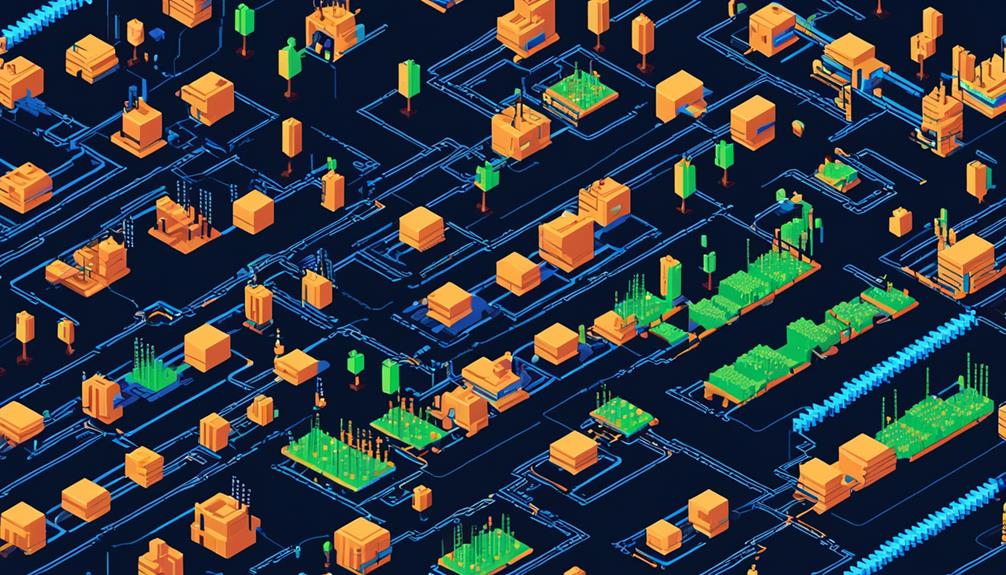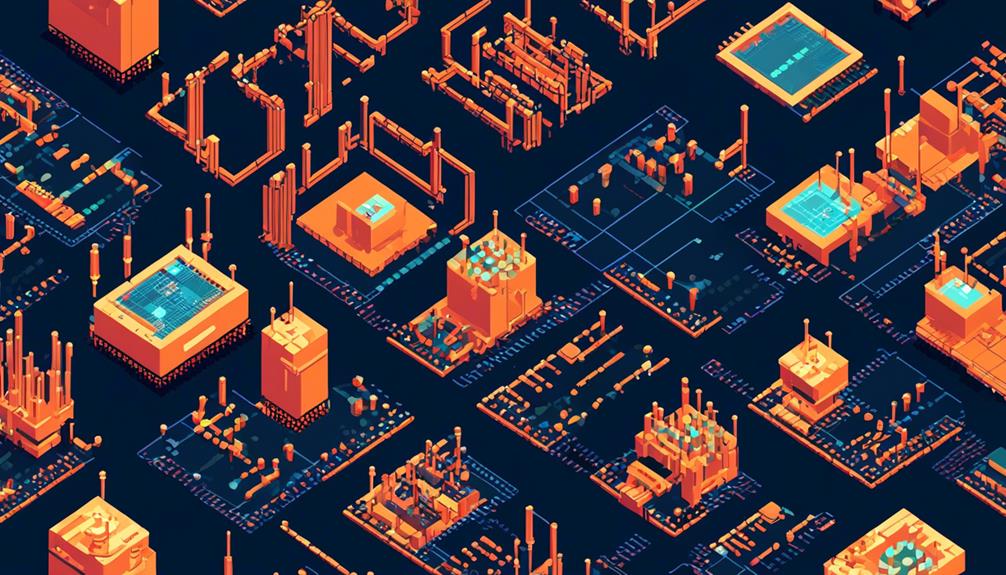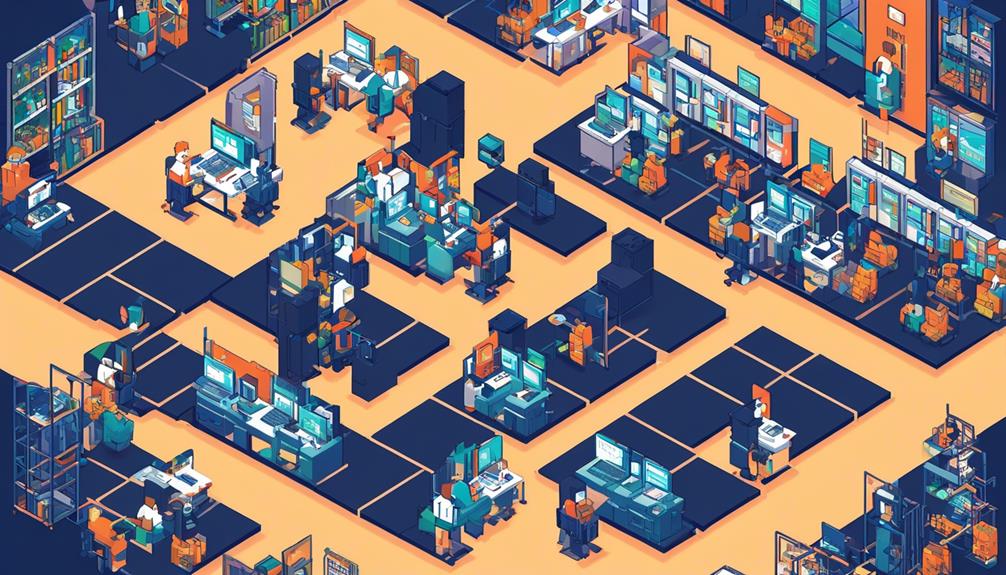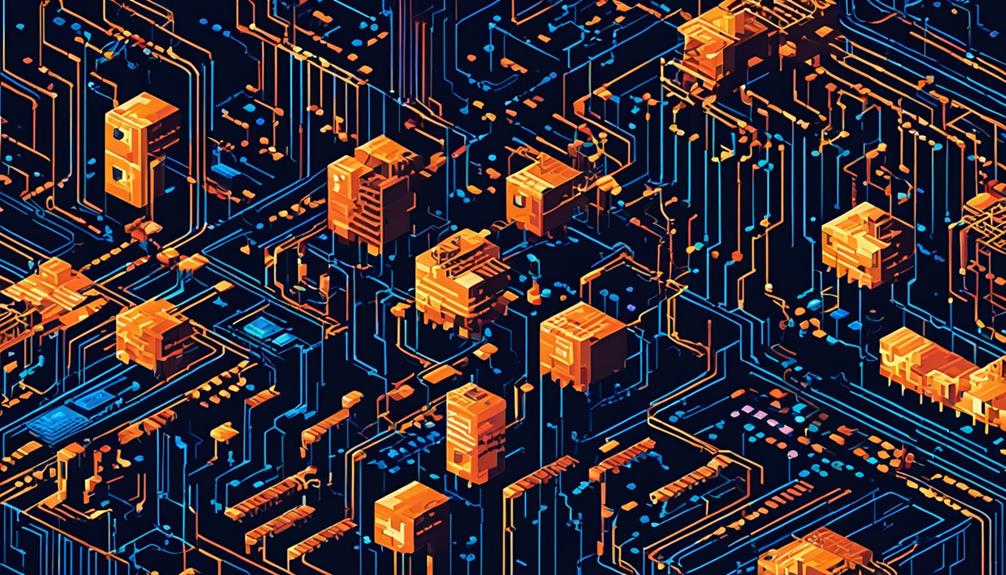The evolution of fiber optic networks has been a steady and methodical journey of technological advancements that have revolutionized the way we communicate and transfer data.
From its inception as a theoretical concept in the 1960s, fiber optics has undergone significant developments, resulting in faster data transmission speeds, improved reliability, and unparalleled performance.
As we delve into the intricacies of fiber optic technology, we will explore the early developments in fiber optics, the advantages it offers, its impact on global communications, the evolution of transmission systems, and the challenges faced in expanding fiber optic infrastructure.
By examining the benefits of fiber optic networks for businesses and consumers, we will gain a deeper understanding of the pivotal role this technology plays in shaping our digital landscape.
Key Takeaways
- Fiber optic technology has evolved significantly over the years, with the introduction of LED and multimode fiber in the 1970s and single-mode fiber in the 1980s, enabling higher transmission speeds.
- Fiber optic networks offer numerous advantages over copper-based networks, including higher bandwidth, immunity to electromagnetic interference, minimal signal loss over long distances, and easier installation and maintenance.
- Fiber optic technology has had a significant impact on global communications, increasing transmission capacity, reducing signal loss during data transmission, optimizing data centers, and facilitating seamless communication between individuals, businesses, and organizations worldwide.
- The evolution of fiber optic transmission systems has seen advancements such as dense wavelength division multiplexing (DWDM), coherent transmission technology, modulation format improvements, increased transmission speeds (e.g., 100 Gbps, 400 Gbps), and the adoption of software-defined networking (SDN) and network function virtualization (NFV).
Early Developments in Fiber Optics

The early developments in fiber optics revolutionized digital communication by replacing electronics and coaxial cables with the introduction of LED and multimode fiber. These advancements enabled higher transmission capacities and distances, marking a significant milestone in the field of optical communication.
Prior to the 1970s, digital communication heavily relied on electronics and coaxial cables, which had limitations in terms of transmission capacity and distance.
The introduction of LED and multimode fiber in the 1970s addressed these limitations. LED, or light-emitting diode, provided a reliable and efficient light source for optical transmission. Multimode fiber, on the other hand, allowed for the transmission of multiple signals simultaneously through the use of multiple paths or modes within the fiber. This enabled single channel capacities of 45-90 Mbps and transmission distances of up to 10 kilometers.
The 1980s saw the introduction of single-mode fiber, which further revolutionized optical communication. Single-mode fiber, with its smaller core diameter, allowed for higher transmission speeds of up to 2.5 gigabits per second (Gbps). This significant increase in transmission speed opened up new possibilities for data-intensive applications and paved the way for the development of more advanced optical networks.
In the 1990s, multimode fiber underwent further advancements, enabling even higher transmission speeds of up to 10 Gbps. Additionally, practical optical amplifiers known as erbium-doped fiber amplifiers (EDFA) were introduced, providing the means to amplify optical signals without converting them back into electrical signals. This breakthrough allowed for transmission distances of nearly 1000 kilometers at speeds of 2.5 and 10 Gbps.
Advantages of Fiber Optic Technology
With its higher bandwidth, immunity to electromagnetic interference, minimal signal loss, and easy installation and maintenance, fiber optic technology offers numerous advantages over traditional copper cables in the field of digital communication.
- Higher bandwidth: Fiber optic cables have a much higher bandwidth compared to copper cables, allowing for the transmission of large amounts of data at high speeds. This makes fiber optic technology ideal for applications that require fast and efficient data transfer, such as streaming high-definition videos or online gaming.
- Immunity to electromagnetic interference: Unlike copper cables, fiber optic cables are immune to electromagnetic interference. This means that optical signals can be transmitted without any degradation or distortion, even in environments with high levels of electromagnetic noise. This makes fiber optic technology especially suitable for industries where electromagnetic interference is a concern, such as healthcare, aerospace, and industrial automation.
- Minimal signal loss: Fiber optic cables experience minimal signal loss, allowing for data to be transmitted over long distances without degradation. This makes fiber optic technology perfect for applications that require long-range communication, such as telecommunication networks, internet backbone infrastructure, and submarine cables.
- Easy installation and maintenance: Fiber optic cables are lightweight and flexible, making them easy to install and maintain. They can be easily routed around corners, through tight spaces, and even underwater. Additionally, fiber optic networks require fewer repeaters and amplifiers compared to copper-based networks, reducing the complexity and cost of installation and maintenance.
Fiber Optic Networks in Telecommunications

Evolutionary advancements in fiber optic technology have revolutionized the telecommunications industry, enabling the development of high-speed and reliable fiber optic networks. Fiber optic networks in telecommunications rely on the use of glass fibers for optical transmission. These fibers are capable of transmitting data over long distances with minimal signal loss, making them ideal for telecommunications applications.
One of the key advantages of fiber optic networks in telecommunications is their high transmission capacity. Unlike traditional copper-based networks, fiber optic networks can support much higher data rates. This is due to the fact that fiber optic cables can transmit data using multiple channels simultaneously, each carrying a single channel of data. This allows for increased bandwidth and higher data transmission rates.
In addition to their high transmission capacity, fiber optic networks also offer other benefits for telecommunications applications. They are immune to electromagnetic interference, making them more reliable in environments with high levels of electrical noise. Fiber optic networks are also more secure, as they are difficult to tap into without detection.
The development of fiber optic networks in telecommunications has also led to advancements in network architecture. With fiber optic networks, it is possible to create large-scale networks that span vast distances, connecting multiple locations together. This has facilitated the growth of global telecommunications networks, enabling seamless communication across the world.
Impact of Fiber Optics on Global Communications
Advancements in fiber optic technology have transformed global communications by enabling high-speed data transmission over vast distances, revolutionizing the way data is exchanged on a global scale. The impact of fiber optics on global communications can be seen in several key areas:
- Increased transmission capacity: Fiber optics has significantly increased the transmission capacity compared to traditional copper-based systems. Optical fibers can carry a large amount of data simultaneously, allowing for higher bandwidth capabilities and accommodating the growing demand for data transmission in the digital age.
- Reduced signal loss: Fiber optics has revolutionized global communications by minimizing signal loss during data transmission. Unlike copper cables, optical fibers have a higher signal-to-noise ratio, ensuring that the transmitted data remains clear and intact over long distances.
- Data center optimization: Fiber optics has played a crucial role in optimizing data centers. With the ability to transmit data at high speeds over long distances, optical fiber cables connect data centers across the globe, enabling efficient data exchange and storage. This has paved the way for cloud computing, big data analytics, and other data-intensive applications.
- Global connectivity: Fiber optics has revolutionized global connectivity by bridging geographical gaps. With the ability to transmit data over long distances without significant signal degradation, fiber optic networks have facilitated seamless communication between individuals, businesses, and organizations worldwide.
Evolution of Fiber Optic Transmission Systems

The evolution of fiber optic transmission systems has been characterized by significant advancements in transmission speed, increased bandwidth capacity, and enhanced signal quality.
Through the development of new fiber types such as graded index (GI) and laser optimized (LO) fibers, transmission distances and bandwidth capabilities have greatly improved.
Advancements in optoelectronics and multiplexing technologies have allowed for higher transmission speeds and the ability to meet the growing demands for increased data transmission.
Transmission Speed Advancements
Significant advancements have been made in the transmission speed of fiber optic networks, revolutionizing the capabilities of data transfer. These advancements have greatly improved the efficiency and speed of fiber-optic communications.
Here are some key developments in transmission speed advancements:
- Shift from LED to VCSEL: The use of VCSEL (Vertical-Cavity Surface-Emitting Laser) as the light source has enabled higher bit rates in fiber optic networks.
- Advancements in multimode fiber technology: Improved multimode fiber technology has led to enhanced bandwidth and increased transmission distance.
- OM5 fiber with CWDM and VCSELs: OM5 fiber, utilizing Coarse Wavelength Division Multiplexing (CWDM) and VCSELs, allows for transmission speeds of 40 or 100 Gbits/sec over one fiber pair.
- Parallel transmission: Parallel transmission techniques are employed to achieve higher data transmission rates while using multimode fiber.
These advancements in transmission speed have paved the way for faster and more efficient data rates in fiber optic networks, making it possible to transmit large volumes of data quickly and reliably, especially when using single-mode fiber.
Increased Bandwidth Capacity
Increased bandwidth capacity in fiber optic transmission systems has been achieved through the development of advanced multimode fiber technology.
The introduction of graded index (GI) fiber has significantly increased the bandwidth and transmission distance compared to step index (SI) fiber. This improvement is due to the ability of GI fiber to reduce modal dispersion, allowing for higher transmission rates and higher bandwidth.
Additionally, the use of vertical cavity surface emitting lasers (VCSELs) as a light source has further enhanced the bandwidth and transmission capabilities of multimode fiber. VCSELs enable higher bit rates and improved bandwidth on multimode fiber, pushing the limits of its capacity.
Furthermore, the introduction of OM5 fiber has addressed the increasing demand for higher bandwidth and transmission distance by allowing the transmission of 40 or 100 Gbits/sec over a single fiber pair.
Parallel transmission has also played a crucial role in achieving increased bandwidth capacity by enabling higher transmission rates on multimode fiber without the need to switch to singlemode transmission.
Enhanced Signal Quality
Building upon the advancements in multimode fiber technology and the introduction of graded index fiber, the evolution of fiber optic transmission systems has led to significant improvements in signal quality through enhanced fiber types and innovative solutions. These advancements have been crucial in meeting the growing demands for lightning-fast data transfer and increased bandwidth.
- Improved fiber types, such as step index and graded index fibers, have addressed bandwidth and transmission distance limitations, resulting in enhanced signal quality.
- Advancements in multimode fiber, including the development of laser-optimized fibers and parallel transmission solutions, have greatly improved signal quality and transmission capabilities.
- The introduction of OM5 fiber has further enhanced signal quality by enabling high-speed transmission rates using coarse wavelength division multiplexing and advanced light sources.
- Fiber optic speed evolution plays a vital role in achieving enhanced signal quality, ensuring efficient transmission of light signals through optical fibers.
These advancements have revolutionized the field of fiber optic transmission systems, allowing for efficient and reliable transmission of data signals.
Role of Fiber Optics in the Digital Age

Fiber-optic networks have played a vital role in meeting the ever-growing demands of the digital age, evolving significantly to provide improved performance and transmission capabilities. In today's digital age, fiber-optic transmission has become the backbone of long-haul communication due to its ability to transmit data over long distances with minimal loss of signal quality.
The role of fiber optics in the digital age is crucial for the efficient and reliable transmission of vast amounts of data. The evolution of fiber optics has led to the development of various fiber types, each with its own improved capabilities for bandwidth and transmission distance. For example, step index (SI) fiber, graded index (GI) fiber, and multimode fiber have all seen advancements that enhance their performance.
Advancements in multimode fiber technology have allowed for enhanced light transmission and dispersion reduction. The transition from using light-emitting diodes (LEDs) to vertical cavity surface emitting lasers (VCSELs) has significantly improved the transmission capabilities of multimode fiber. This improvement has made it possible to accommodate higher transmission rates without the need to switch to single-mode transmission.
Furthermore, parallel transmission has emerged as a solution to support higher transmission rates, allowing the continued use of multimode fiber. This technique enables multiple data streams to be transmitted simultaneously, increasing the overall capacity of the fiber-optic network.
The introduction of OM5 fiber has further elevated fiber-optic transmission capabilities in the digital age. OM5 fiber enables the transmission of 40 or 100 Gbits/sec over a single fiber pair through coarse wavelength division multiplexing (CWDM) and VCSELs. This advancement has significantly increased the bandwidth and transmission capacity of fiber-optic networks.
Fiber Optic Technology and Data Transmission
Fiber optic technology has revolutionized data transmission with its remarkable advancements and unparalleled performance capabilities. The evolution of fiber-optic communications technology has brought about significant improvements in the field, enabling faster and more reliable data transmission.
Here are some key developments in fiber optic technology and data transmission:
- Fiber-optic transmission: Fiber-optic cables are at the heart of fiber communication systems. These cables consist of a core, which carries the optical signal, and a cladding layer, which helps contain and guide the light within the core. The use of fiber-optic cables allows for the transmission of data over long distances with minimal loss and interference.
- Data transmission: Fiber optic technology enables the transmission of vast amounts of data at incredibly high speeds. Compared to traditional copper-based transmission systems, fiber-optic transmission offers significantly higher bandwidth, allowing for faster and more efficient data transfer.
- Fiber communication: Fiber optic technology is widely used in various communication systems, including telecommunications networks, internet infrastructure, and data centers. Its ability to transmit large amounts of data quickly and reliably makes it an ideal choice for handling the ever-increasing demands of modern communication networks.
- Optical amplification: To ensure that the optical signals transmitted through fiber-optic cables maintain their strength over long distances, optical amplification techniques are employed. These techniques involve the use of devices such as erbium-doped fiber amplifiers (EDFAs) to boost the strength of the optical signals without converting them into electrical signals.
Growth of Fiber Optic Networks Worldwide

The global expansion of high-speed data transmission networks has seen remarkable growth, driven by the increasing demand for faster connectivity and higher bandwidth capabilities. Fiber optic networks have played a crucial role in meeting this ever-increasing demand, offering superior performance and reliability compared to traditional copper-based networks.
The growth of fiber optic networks worldwide can be attributed to several factors.
One key factor is the ability of fiber-optic transmission to support long-haul communication systems. With the advancements in fiber technology, data can now be transmitted over long distances without significant degradation in signal quality. This has enabled the establishment of fiber optic networks across vast geographical areas, connecting cities, countries, and continents.
Another driving force behind the worldwide growth of fiber optic networks is the continuous evolution of fiber optic components. Fibers, cables, connectors, and optoelectronics have all undergone significant advancements, allowing for higher transmission speeds, increased bandwidth, and greater reliability. For instance, the introduction of OM5 fiber has revolutionized the industry by enabling the transmission of 40 or 100 Gbits/sec over a single fiber pair. This breakthrough in fiber technology has been instrumental in meeting the escalating bandwidth demands of data-intensive applications.
Furthermore, parallel transmission has emerged as a solution for achieving higher transmission rates over multimode fiber. By utilizing multiple fibers simultaneously, parallel transmission allows for the continued use of multimode fiber while avoiding the increased cost associated with switching to singlemode transmission. This has further accelerated the deployment of fiber optic networks worldwide.
Innovations in Fiber Optic Cable Design
With the continuous evolution of fiber optic networks, advancements in cable design have emerged to meet the ever-increasing demands for higher bandwidth and improved transmission capabilities. These innovations have revolutionized the way data is transmitted through fiber optic cables, allowing for faster and more efficient communication.
Some of the key innovations in fiber optic cable design include:
- Step index (SI) and graded index (GI) fibers: These fibers are designed to optimize the transmission of light signals through the use of glass fibers. The step index fiber has a uniform refractive index, while the graded index fiber has a varying refractive index. Both types of fibers improve bandwidth and transmission distance by reducing signal loss and dispersion.
- Laser-optimized (LO) fibers: As the demand for higher bandwidth continues to grow, the development of laser-optimized fibers has become crucial. These fibers are designed to optimize the transmission of laser signals, allowing for higher data rates over longer distances.
- Parallel transmission: To meet higher bandwidth demands, fiber optic cable design has embraced parallel transmission. This involves using multiple wavelength channels simultaneously to increase the overall data transmission capacity. By utilizing these wavelength channels, fiber optic networks can achieve higher data rates at a lower cost.
- OM5 fiber: OM5 fiber, also known as wideband multimode fiber, offers a higher level of transmission capabilities. By utilizing coarse wavelength division multiplexing (CWDM) and vertical-cavity surface-emitting laser (VCSEL) technology, OM5 fiber enables higher transmission rates over one fiber pair. This allows for increased bandwidth and improved efficiency in data transmission.
These innovations in fiber optic cable design have paved the way for the future of fiber optic networks. The use of singlemode fiber is expected to become more prevalent, as it can support even higher bandwidth demands. Additionally, further advancements in cable design will continue to push the limits of data transmission capacities, enabling faster and more efficient communication at a global level.
Fiber Optic Networks and High-Speed Internet

As the demand for high-speed internet continues to grow, fiber optic networks have emerged as the ideal infrastructure to meet these requirements. With advancements in fiber optic technology, internet speeds have significantly increased, offering faster and more reliable connections for users.
The benefits of fiber optics include higher bandwidth capabilities, low latency, and the ability to transmit data over long distances without signal degradation, making it the preferred choice for high-speed internet applications.
Internet Speed Advancements
Fiber optic networks have revolutionized the speed of internet connectivity through continuous advancements in technology. Here are some key advancements that have contributed to faster internet speeds:
- Advancements in multimode fiber: Multimode fiber allows for the transmission of multiple light rays simultaneously, increasing the overall data transmission rate.
- Introduction of Vertical Cavity Surface Emitting Lasers (VCSELs): VCSELs offer higher power efficiency and faster data transfer rates over multimode fibers, improving internet speeds.
- Parallel transmission: By using multiple fibers simultaneously, parallel transmission enables higher data transfer rates, further enhancing internet speeds.
- Introduction of OM5 fiber: OM5 fiber enables transmission of 40 or 100 Gbits/sec over a single fiber pair, significantly increasing internet speeds.
These advancements, combined with the use of glass fibers and the speed of light, have propelled internet speeds to new heights, providing users with faster and more reliable connectivity.
Fiber Optic Infrastructure
The evolution of fiber optic networks has paved the way for high-speed internet connectivity. This revolution has transformed the way we transmit data through the use of advanced fiber optic infrastructure.
Fiber optic infrastructure enables high-speed internet and data transmission through thin strands of glass or plastic cables. These cables, also known as optical fibers, carry data using pulses of light.
The advancements in fiber optics have led to the development of different fiber types such as step index (SI) and graded index (GI) fibers. These fibers improve bandwidth and transmission distance, enhancing the overall performance of fiber optic networks.
For long-haul fiber-optic transmission, single fiber is used to transmit data over long distances without the need for signal regeneration. This is made possible by the use of advanced fiber optic infrastructure that includes repeaters and amplifiers. These components help maintain the signal strength and ensure reliable transmission over long distances.
Looking ahead, the future of fiber optic infrastructure involves the use of singlemode fiber. This type of fiber enables higher bandwidth and transmission distance, meeting the growing demand for faster data transfer and bandwidth-intensive applications. By adopting singlemode fiber, fiber optic networks can continue to evolve and meet the needs of an increasingly connected world.
Benefits of Fiber Optics
With its unparalleled bandwidth capabilities and immunity to electromagnetic interference, fiber optic technology revolutionizes high-speed internet connectivity. Here are the key benefits of fiber optics:
- Increased Bandwidth: Fiber optic networks offer significantly higher bandwidth capabilities compared to traditional copper cables. This means that more data can be transmitted simultaneously, resulting in faster and more efficient data transfer.
- Reliable Data Transmission: Fiber optic technology is immune to electromagnetic interference, ensuring reliable and consistent data transmission. This is particularly important in environments with high levels of electromagnetic activity, such as industrial settings or areas with heavy electrical equipment.
- High-Speed Data Transfer: The speed of data transmission in fiber optic cables is remarkably high, meeting the increasing bandwidth demands of modern applications and devices. Whether it's streaming high-definition videos, online gaming, or large file transfers, fiber optics enable lightning-fast data transfer.
- Long-Haul Communication: Fiber optic signals can travel over great distances without degradation, making them suitable for long-haul communication networks. This makes fiber optics ideal for connecting different locations, such as offices in different cities or countries, with minimal signal loss or latency.
Fiber Optics and the Future of Telecommunications

Advancements in communications technology have paved the way for the future of telecommunications, with fiber optics playing a crucial role in enabling improved performance and capabilities. The evolution of fiber-optic networks has brought about significant changes in the way we transmit data over long distances. By using glass fibers to transmit data as pulses of light, fiber optics have revolutionized the telecommunications industry.
To better understand the advancements in fiber optics and their impact on the future of telecommunications, let's take a look at the following table:
| Fiber Type | Advancements |
|---|---|
| Step Index | Initial form of fiber optics |
| Graded Index | Improved bandwidth and transmission distance |
| Multimode | Higher bandwidth and transmission distances |
| Singlemode | Longer transmission distances and higher speeds |
Transmission through fiber-optic networks offers several advantages over traditional copper-based systems. Fiber optics can transmit data over longer distances without loss of quality or signal degradation. They also have a much higher bandwidth, allowing for faster and more efficient data transmission. Additionally, fiber optics are immune to electromagnetic interference, making them ideal for use in environments with high levels of electrical noise.
In terms of transmission, fiber optics offer superior performance. The introduction of laser-optimized (LO) fibers and parallel transmission techniques has further improved the transmission distances and rates achievable with multimode fibers. For example, the use of OM5 fiber, combined with coarse wavelength division multiplexing (CWDM) and vertical-cavity surface-emitting lasers (VCSELs), enables transmission of 40 or 100 Gbits/sec over a single fiber pair.
As technology continues to advance, fiber optics will continue to play a crucial role in the future of telecommunications. The demand for faster and more reliable data transmission will drive further developments in fiber-optic networks, ensuring that they remain at the forefront of telecommunications technology.
Challenges in Expanding Fiber Optic Infrastructure
Addressing the fragility of fiber optic cables and the complexities of installation and maintenance pose significant challenges in expanding fiber optic infrastructure.
Fiber optic cables consist of delicate glass fibers that transmit data through pulses of light. These cables are susceptible to damage from bending, stretching, and excessive tension. Therefore, careful handling and maintenance are crucial to ensure the longevity and reliability of the network.
Expanding fiber optic infrastructure requires overcoming the complexities of installation and maintenance. Unlike traditional copper cables, fiber optic cables require specialized equipment and techniques for proper installation. The process involves carefully splicing and connecting individual fibers to create a seamless pathway for fiber-optic transmission. Moreover, the installation of fiber optic cables often involves complex routing through existing infrastructure, such as utility poles and underground conduits. This adds another layer of complexity and requires coordination with various stakeholders.
Upgrading existing infrastructure to accommodate fiber optic technology is another challenge. Many existing networks rely on outdated copper cables, which cannot support the high-speed data transmission capabilities of fiber optics. Upgrading infrastructure involves replacing or retrofitting existing cables, which requires careful planning and coordination to minimize disruptions to service and ensure a seamless transition.
The expansion of fiber optic infrastructure also necessitates a skilled workforce of trained technicians. Fiber optic networks require specialized knowledge and expertise in handling and maintaining the delicate cables. Technicians must be proficient in troubleshooting and repairing fiber optic connections to minimize downtime and ensure uninterrupted data transmission.
Benefits of Fiber Optic Networks for Businesses and Consumers

Fiber optic networks offer businesses and consumers high-speed and efficient data transmission, meeting the growing demand for bandwidth while ensuring reliable and consistent connectivity. The benefits delivered by fiber optic networks are numerous and have revolutionized the way organizations and individuals interact with technology.
One of the key advantages of fiber optic networks is their ability to provide lightning-fast data transfer speeds. With faster speeds, businesses can support bandwidth-hungry applications and devices, enabling them to operate more efficiently and effectively. Consumers also benefit from these higher speeds, enjoying seamless streaming, gaming, and downloading experiences.
Another significant benefit of fiber optic networks is their reliability. Unlike traditional copper-based networks, fiber optics are unaffected by electromagnetic interference or weather conditions. This ensures uninterrupted connectivity, even in adverse conditions, making fiber optic networks a future-proof solution for organizations.
Moreover, the capability of fiber optic signals to travel long distances without degradation makes them ideal for long-haul communication networks. Businesses can connect their remote offices, branches, and data centers seamlessly, increasing productivity and collaboration. Consumers also benefit from this extended reach, as it allows for seamless connectivity and access to services and content from anywhere.
To summarize the benefits of fiber optic networks for businesses and consumers, the following table provides a quick overview:
| Benefits | Description |
|---|---|
| High-speed data transmission | Fiber optic networks offer fast data transfer speeds, enabling efficient operations and seamless user experiences. |
| Reliable connectivity | Fiber optics are immune to electromagnetic interference and weather conditions, ensuring uninterrupted connectivity. |
| Extended reach | Fiber optic signals can travel long distances without degradation, allowing for seamless connectivity across locations. |
Frequently Asked Questions
How Has Fiber Optics Evolved?
Fiber optics has undergone significant advancements in technology, resulting in numerous benefits and applications.
Over time, the evolution of fiber optics has led to improved performance and capabilities. Advancements in fiber types, such as step index, graded index, and multimode fibers, have addressed limitations related to bandwidth and transmission distance.
Laser optimized fibers and parallel transmission have enabled higher transmission rates. The introduction of OM5 fiber has further increased bandwidth and transmission distance.
These advancements have revolutionized various industries, including telecommunications, data transmission, and networking.
What Is the History of Fiber Optic Cable?
Fiber optic cable has a rich history that dates back to the 1960s when it was first conceptualized and developed as a theoretical concept.
Over the years, fiber optic technology has undergone significant advancements, leading to higher data transmission speeds and improved telecommunications infrastructure.
Today, fiber optic cables are widely used for data transmission, including underwater cables that connect continents.
These cables utilize the unique properties of light to transmit large amounts of data quickly and efficiently.
What Is the History of Fiber Optic Sensing?
Fiber optic sensing has a rich history that parallels the development of fiber optic communication. Advancements in fiber optic technology have paved the way for various applications in sensing, such as structural health monitoring, oil and gas exploration, and environmental sensing.
Fiber optic sensing offers numerous benefits, including high accuracy, immunity to electromagnetic interference, and the ability to cover long distances. However, challenges such as signal attenuation and cost constraints continue to be areas of focus for further advancements in fiber optic sensing.
What Is the Future of Fiber Optic Networks?
The future of fiber optic networks is poised to revolutionize communication technology. Advantages of fiber optic networks include high-speed data transfer, greater bandwidth, and longer transmission distances.
However, there are also disadvantages such as high installation costs and vulnerability to physical damage.
Emerging trends in fiber optic network infrastructure involve the use of single-mode fiber for higher bandwidth and the introduction of OM5 fiber for increased transmission speeds.
Fiber optics will play a crucial role in shaping the future of the internet, enabling faster and more efficient data transmission.

